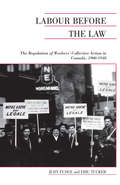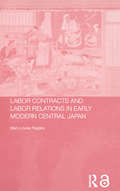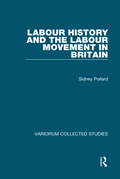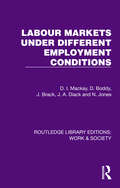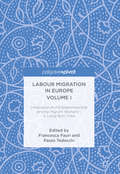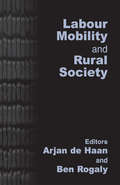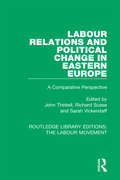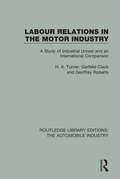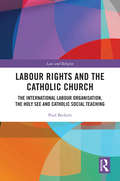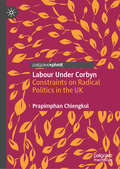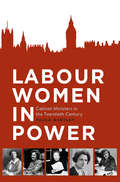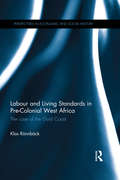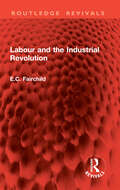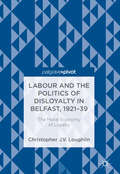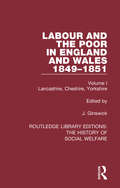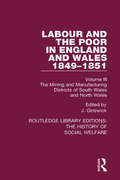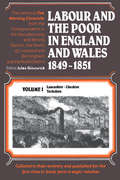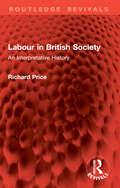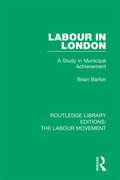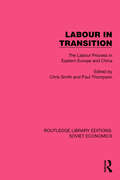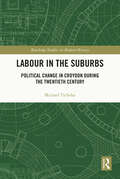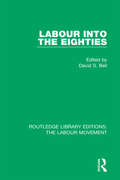- Table View
- List View
Labour Before the Law
by Judy Fudge Eric TuckerIn this groundbreaking study of the relations between workers and the state, Judy Fudge and Eric Tucker examine the legal regulation of workers' collective action from 1900 to 1948. They analyze the strikes, violent confrontations, lockouts, union organizing drives, legislative initiatives, and major judicial decisions that transformed the labour relations regime of liberal voluntarism, which prevailed in the later part of the nineteenth century, into industrial voluntarism, whose centrepiece was Mackenzie King's Industrial Disputes Investigation Act of 1907. This period was marked by coercion and compromise, as workers organized and fought to extend their rights against the profit oriented owners of capital, while the state struggled to define a labour regime that contained industrial conflict. The authors then trace the conflicts that eventually produced the industrial pluralism that Canadians have known in more recent years.By 1948 a detailed set of legal rules and procedures had evolved and achieved a hegemonic status that no prior legal regime had even approached. This regime has become so central to our everyday thinking about labour relations that one might be forgiven for thinking that everything that came earlier was, truly, before the law. But, as Labour Before the Law demonstrates, workers who acted collectively prior to 1948 often found themselves before the law, whether appearing before a magistrate charged with causing a disturbance, facing a superior court judge to oppose an injunction, or in front of a board appointed pursuant to a statutory scheme that was investigating a labour dispute and making recommendations for its resolution.The book is simultaneously a history of law, aspects of the state, trade unions and labouring people, and their interaction within the broad and shifting terrain of political economy. The authors are attentive to regional differences and sectoral divergences, and they attempt to address the fragmentation of class experience.
Labour Contracts and Labour Relations in Early Modern Central Japan (Changing Labour Relations in Asia)
by Mary Louise NagataBased on a collection of labour contracts and other documents, this book examines the legal, economic and social relations of labour as they developed in the commercial enterprises of Tokugawa Japan. The urban focus is Kyoto, the cultural capital and smallest of the three great cities of the Tokugawa period, but the data comes from a wider region of commercial and castle towns and rural villages in central Japan.
Labour History and the Labour Movement in Britain (Variorum Collected Studies)
by Sidney PollardThis volume focuses on labour history in Britain, but brings in comparative material on the Continent, in particular inter-war Germany. Special attention is given to wages and living and working conditions in the 19th century, to Robert Owen and Co-operation, and to the modern trade union movement and its attempts to keep up the interests of its members in the fluctuating conditions of the late 19th and earlier 20th centuries. The author defends the notion that wage-earners have common interests and frequently share common experiences, and that their organisations have both a strictly economic aspect (trade unions) and a wider political dimension. The profound changes which the labour organisations underwent in the 19th and 20th centuries are a major concern of these essays.
Labour Markets Under Different Employment Conditions (Routledge Library Editions: Work & Society)
by D. Boddy N. Jones D. I. Mackay J. Brack J. A. DiackOriginally published in 1971, this wide-ranging study illuminates many crucial wage and employment issues by examining the operation of local labour markets and by testing labour market theory against the observed behaviour of employers and employees in different labour market environments. It is based on an empirical investigation of engineering plants both in major conurbations and in smaller labour market areas. There is an emphasis on measurement and quantification, which provides a fund of information on such subjects as wage structures, labour turnover, recruitment and mobility, internal labour markets, manpower forecasting, apprentice training and redundancy. The authors outline the weaknesses of applying economic theory to labour market behaviour.
Labour Migration in Europe Volume I: Integration and Entrepreneurship among Migrant Workers – A Long-Term View
by Francesca Fauri Paolo TedeschiIn this book, Fauri and Tedeschi bring together contributions that outline the movement of job seekers and ethnic minority entrepreneurs in Europe, to analyse the overall impact of different forms of migration on European economies in the last 100 years. Contributions address a broad range of themes, from the motivations of migrants and the process of their integration into their destination country, to their overall social and economic impact onto said country at a structural level. In addressing questions as to why some ethnic groups seem to compete more successfully in business, as well as addressing questions about how skilled labour can be attracted and retained, this volume forms part of a very important multidisciplinary dialogue on labour migration. The policy implications of answering such questions are also discussed, as contributors ultimately examine whether skills-dependent migration policy needs to form part of a common strategy, either at a national or an international level.
Labour Mobility and Rural Society
by Arjan De Haan Ben RogalyComprising seven edited pieces of detailed empirical work drawn from recent research, this title reveals the dynamics behind the movements of poor people in South and South East Asia and Africa.
Labour Relations and Political Change in Eastern Europe: A Comparative Perspective (Routledge Library Editions: The Labour Movement #39)
by Stephen G. JonesFirst published in 1995. This volume offers a comparative perspective on labour relations and political change in eastern Europe within a common theoretical and empirical framework. Its coverage includes Bulgaria, and Czech and Slovak republics, Hungary, Poland, and Russia. Particular attention is given to the dynamics of changes in labour relations and privatisation, which are now critical to the more general process of political and economic transformation. This title will be of interest to scholars and students of politics, sociology and modern history.
Labour Relations in the Motor Industry: A Study of Industrial Unrest and an International Comparison (Routledge Library Editions: The Automobile Industry)
by Geoffrey Roberts H. A. Turner Garfield ClackThis book, originally published in 1967, takes the automobile industry experience as a basis for a wider view of industrial relations, trends and developments of the 1950s and 60s. The study also analyses the emergence of new institutions and systems of labour-management relationships. It contains chapters on the effects of automotion and technical change, on the impact of fluctuations in the market for cars and on wage trends. There are detailed surveys of some of the biggest post-war disputes and especially of trade union organization, the shop steward system, the experience of individual firms, such as Austin, Ford and Fiat. There is also a comparative survey of labour relationships in other major car manufacturing countries such as the USA, Germany and Japan.
Labour Rights and the Catholic Church: The International Labour Organisation, the Holy See and Catholic Social Teaching (Law and Religion)
by Paul BeckettThis book explores the extent of parallelism and cross-influence between Catholic Social Teaching and the work of the world’s oldest human rights institution, the International Labour Organisation (ILO). Sometimes there is a mutual attraction between seeming opposites who in fact share a common goal. This book is about just such an attraction between a secular organisation born of the political desire for peace and justice, and a metaphysical institution much older founded to bring peace and justice on earth. It examines the principles evident in the teachings of the Catholic Church and in the secular philosophy of the ILO; together with the theological basis of the relevant provisions of Catholic Social Teaching and of the socio-political origins and basis of the ILO. The spectrum of labour rights covered in the book extends from the right to press for rights, i.e., collective bargaining, to rights themselves – conditions in work – and on to post-employment rights in the form of social security and pensions. The extent of the parallelism and cross-influence is reviewed from the issue of the Papal Encyclical of Pope Leo XIII Rerum Novarum (1891) and from the founding of the ILO in 1919. This book is intended to appeal to lay, professional and academic alike, and will be of interest to researchers and academics working in the areas of international human rights, theology, comparative philosophy, history and social and political studies. On 4 January 2021 it was granted an Imprimatur by the Roman Catholic Archbishop of Liverpool, Malcolm P. McMahon O.P., meaning that the Catholic Church is satisfied that the book is free of doctrinal or moral error.
Labour Under Corbyn: Constraints on Radical Politics in the UK
by Prapimphan ChiengkulThis book provides an accessible yet critical analysis of the Labour Party under the leadership of Jeremy Corbyn (2015-2020) in the context of the contemporary British political economy. It analyses structural constraints on left-wing politics and evaluates the transformative potential of Labour’s economic and social policies under Corbyn. Drawing from a neo-Marxist and neo-Gramscian framework, the book argues that the material, institutional and ideological conditions before 2015 opened political space for a left-wing Labour Party, although the dominant historical structures severely limited its chance of coming to power. In addition, the book argues that Labour under Corbyn should not be dismissed as ‘populist’, and that its policies aimed to redress structural economic problems, promote economic democracy and tackle contemporary challenges. The book also highlights the importance of adopting a long-term approach to counter-hegemonic political struggle so as not to shrink the space for progressive politics.
Labour Women in Power: Cabinet Ministers in the Twentieth Century
by Paula BartleyThis book examines the political lives and contributions of Margaret Bondfield, Ellen Wilkinson, Barbara Castle, Judith Hart and Shirley Williams, the only five women to achieve Cabinet rank in a Labour Government from the party’s creation until Blair became Prime Minister. Paula Bartley brings together newly discovered archival material and published work to provide a survey of these women, all of whom managed to make a mark out of all proportion to their numbers. Charting their ideas, characters, and formative influences, Bartley provides an account of their rise to power, analysing their contribution to policy making, and assessing their significance and reputation. She shows that these women were not a homogeneous group, but came from diverse family backgrounds, entered politics in their own discrete way, and rose to power at different times. Some were more successful than others, but despite their diversity these women shared one thing in common: they all functioned in a male world.
Labour and Economic Change in Southern Africa c.1900-2000: Zimbabwe, Zambia and Malawi (Routledge Studies in Modern History)
by Andrew Cohen Rory PilossofThis book explores the social and economic development of Zimbabwe, Zambia and Malawi over the course of the twentieth century. These three countries have long shared and interconnected pasts. All three were drawn into the British Empire at a similar time and the formation of the ill-fated Federation of Rhodesia and Nyasaland formally linked these countries together for a decade in the mid-twentieth century. This formal political relationship created dynamics that resulted in yet closer economic and social links. After Federation, the economic realities of industry, transport and labour supplies meant that these three countries continued to be intricately interconnected. Yet despite these connected pasts, comparative work on the economic histories of Malawi, Zambia and Zimbabwe, and how these change over time, is rare. This book addresses the gap by providing the first comprehensive collection of labour and census data across the twentieth century for these three countries. The different economic models and performances of these states offer good comparison, allowing researchers to look at different models of development, and how these played out over the long-term. The book provides data on population growth and change, industrial and occupational structure, and the various shifts in what the economically active population did. It will be useful for historians, economists, development studies scholars and non-governmental organisations working on twentieth-century and contemporary southern Africa.
Labour and Living Standards in Pre-Colonial West Africa: The Case of the Gold Coast (Perspectives in Economic and Social History)
by Klas RönnbäckSub-Saharan Africa is the poorest region in the world. But its current status has skewed our understanding of the economy before colonization. Rönnbäck reconstructs the living standards of the population at a time when the Atlantic slave trade brought money and men into the area, enriching our understanding of West African economic development.
Labour and the Industrial Revolution (Routledge Revivals)
by E.C. FairchildFirst published in 1923, Labour and the Industrial Revolution is an examination of opinions (1760–1832) on the right place of wage-earner under the State. The idealism of the labourer is attributed to the conditions caused by mechanical devices, which, on their introduction, tend to destroy his individuality. The author treats of the machine as the groundwork of economic and ethical theory and of the modern Labour movement. This book will be of interest to students and researchers of economic history.
Labour and the Politics of Disloyalty in Belfast, 1921-39: The Moral Economy of Loyalty
by Christopher J. V. LoughlinThis book provides the first ‘history from below’ of the inter-war Belfast labour movement. It is a social history of the politics of Belfast labour and applies methodology from history, sociology and political science. Christopher J. V. Loughlin questions previous narratives that asserted the centrality of religion and sectarian conflict in the establishment of Northern Ireland. Labour and the Politics of Disloyalty in Belfast, 1921-39 suggests that political division and violence were key to the foundation and maintenance of the democratic ancien régime in Northern Ireland. It examines the relationship between Belfast Labour, sectarianism, electoral politics, security and industrial relations policy, and women’s politics in the city.
Labour and the Poor in England and Wales - The letters to The Morning Chronicle from the Correspondants in the Manufacturing and Mining Districts, the Towns of Liverpool and Birmingham, and the Rural Districts: Volume I: Lancashire, Cheshire, Yorkshire (Routledge Library Editions: The History of Social Welfare)
by J. GinswickThe Morning Chronicle presented the state of the working classes of Britain before the public with clarity, insight and honesty. Consisting mainly of verbatim statements from the people themselves, it was a medium through which the previously inarticulate masses were able to speak with one firm voice. First published in 1983, this book collates the letters from correspondents based in Lancashire, Cheshire and Yorkshire. The letters improve our knowledge of working-class life in nineteenth century England and Wales and provide a unique insight into the impact of industrialization. This book will be of interest to those studying the history of the working class, labour and poverty.
Labour and the Poor in England and Wales - The letters to The Morning Chronicle from the Correspondants in the Manufacturing and Mining Districts, the Towns of Liverpool and Birmingham, and the Rural Districts: Volume II: Northumberland and Durham, Staffordshire, The Midlands (Routledge Library Editions: The History of Social Welfare)
by J. GinswickThe Morning Chronicle presented the state of the working classes of Britain before the public with clarity, insight and honesty. Consisting mainly of verbatim statements from the people themselves, it was a medium through which the previously inarticulate masses were able to speak with one firm voice. First published in 1983, this book collates the letters from correspondents based in Northumberland and Durham, Staffordshire and the Midlands. The letters improve our knowledge of working-class life in nineteenth century England and Wales and provide a unique insight into the impact of industrialization. This book will be of interest to those studying the history of the working class, labour and poverty.
Labour and the Poor in England and Wales - The letters to The Morning Chronicle from the Correspondants in the Manufacturing and Mining Districts, the Towns of Liverpool and Birmingham, and the Rural Districts: Volume III: The Mining and Manufacturing Districts of South Wales, North Wales (Routledge Library Editions: The History of Social Welfare)
by J GinswickThe Morning Chronicle presented the state of the working classes of Britain before the public with clarity, insight and honesty. Consisting mainly of verbatim statements from the people themselves, it was a medium through which the previously inarticulate masses were able to speak with one firm voice. First published in 1983, this book collates the letters from correspondents based in Wales. The letters improve our knowledge of working-class life in nineteenth century England and Wales and provide a unique insight into the impact of industrialization. This book will be of interest to those studying the history of the working class, labour and poverty.
Labour and the Poor in England and Wales, 1849-1851: Lancashire, Cheshire & Yorkshire
by Jules GinswickFirst Published in 1983. In October 1849 a London newspaper, the Morning Chronicle, announced to its middle-class readers that it was to undertake a survey of the condition of the labouring classes in England and Wales under the general title of “Labour and the Poor”. The reports of the survey were published over a period of two years and provided the mid-nineteenth-century Englishman with the most comprehensive view of the working classes that he had ever seen. The letters to The Morning Chronicle from the manufacturing, mining and rural districts and the towns of Liverpool and Birmingham appear here for the first time in book form and have been organised in eight volumes. This is Volume I and offer insights into labour and the poor in England and Wales 1849 to 1851 in the areas of Lancashire, Cheshire and Yorkshire.
Labour in British Society: An Interpretative History (Routledge Revivals)
by Richard PriceWhat part has organized labour played in the history of modern Britain? To what extent has British society been shaped by working class organization in industry and labour in politics? A major reinterpretation of the relationship between the history of the working class and the history of British society from 1780 to 1980, Labour in British Society (originally published in 1986) traces two recurrent themes—how the pattern of social relations in industry has developed since the Industrial Revolution, and how these patterns have been affiliated to national political and economic developments. This book is a must read for students and researchers of history.
Labour in London: A Study in Municipal Achievement (Routledge Library Editions: The Labour Movement #1)
by Brian BarkerFirst published in 1946. This title is a clear and concise account of the march of Labour to the control of the London County Council and its work at County Hall in the 1940s. This study explores the rise of the Labour Party in London and the changes and progress in health, education, and social welfare. Labour in London will be of interest to students of history and politics.
Labour in Transition: The Labour Process in Eastern Europe and China (Routledge Library Editions: Soviet Economics #9)
by Paul Thompson Chris SmithLabour in Transition (1992) examines the massive transformations undertaken by state socialist regimes at the end of the 1980s. It traces developments in the Soviet Union, Eastern Europe and China, in particular the impact of changes in the labour process and broader political economy. Detailed empirical analysis of reform processes is effectively combined with a broader comparative examination of capitalism, socialism and the process of transition to new social formations.
Labour in a Single Shot: Critical Perspectives on Antje Ehmann and Harun Farocki’s Global Video Project (Film Culture in Transition)
by Peter J. Schwartz Roy Grundmann Gregory H. WilliamsThis collection of essays offers a critical assessment of Labour in a Single Shot, a groundbreaking documentary video workshop. From 2011 to 2014, curator Antje Ehmann and film- and video-maker Harun Farocki produced an art project of truly global proportions. They travelled to fifteen cities around the world to conduct workshops inspired by cinema history’s first film, Workers Leaving the Lumière Factory, shot in 1895 by the Lumière brothers in France. While the workshop videos are in colour and the camera was not required to remain static, Ehmann and Farocki’s students were tasked with honouring the original Lumière film’s basic parameters of theme and style. The fascinating result is a collection of more than 550 short videos that have appeared in international exhibitions and on an open-access website, offering the widest possible audience the opportunity to ponder contemporary labour in multiple contexts around the world.
Labour in the Suburbs: Political Change in Croydon During the Twentieth Century (Routledge Studies in Modern British History)
by Michael TichelarThis book is the first comprehensive economic, social and political study of the London suburb of Croydon from 1900 up to the present day. One of the largest London boroughs, Croydon, has always been a mixed residential suburb (mainly private but with some municipal housing), which has strongly influenced the nature of its political representation. It was never just an affluent middle-class suburb or ‘bourgeoise utopia,’ as suggested by traditional definitions of suburbia and in popular imagination. In economic terms it was also an industrial suburb after 1918. It was then transformed into a vibrant post-industrial service economy following rapid deindustrialisation and remarkable commercial and office redevelopment after 1960. In this respect Croydon is also an ex-industrial suburb, similar to many other outer London areas and other peripheral metropolitan areas. Croydon’s civic identity as a previously independent town on the outskirts of London remains unresolved to this day, even as its political representatives seek to redefine the borough as a more independent ‘Edge City.’ Author Michael Tichelar examines this suburb by looking at the suburban development of London, the changing politics of Croydon and policy issues during the twentieth century. Labour in the Suburbs will be of interest to the general reader as well as students of modern British history with special interests in electoral sociology, political representation and suburbanisation. It provides a template against which to measure the process of suburbanisation in the UK and internationally.
Labour into the Eighties (Routledge Library Editions: The Labour Movement #3)
by David S. BellFirst published in 1980. This book covers areas of policy interest viewed from a social democratic perspective and each chapter takes a specific issue which would have been of concern to Labour in the 1980s, including some of the more controversial areas. The study reviews various problem areas and suggests policies which are realistic and applicable in the conditions of the 1980s. This title will be of interests to scholars and students of history and politics.
